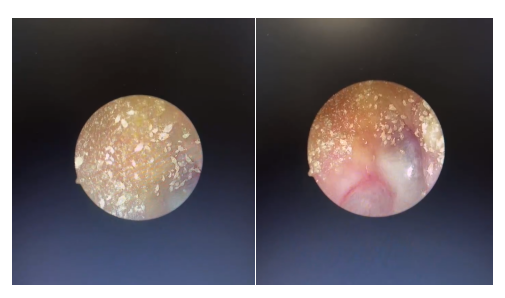A few days ago, after being tortured by intense itches in his right ear for a week, Mr. Lu came to the Sixth Affiliated Hospital of Sun Yat-sen University for help.
Liu Tianrun, chief physician of the Department of Otolaryngology, Head and Neck/Thyroid Surgery of the hospital, gave Lu an electric otoscopy. From the screen, many white dots can be seen, which seemed to be moving, scattered in Lu’s external acoustic meatus and eardrum. Then, with a further ear endoscopy, he found that those moving dots turned out to be wriggling mites.
After inquiries, the doctor finally found the cause. Lu had gotten a cat recently, and there was a high possibility that the mites in his ear resulted from his cat.

(Photo provided to GDToday)
Common foreign objects in the ear
According to Liu, foreign objects in the ear are one of the most-seen emergencies in his department. Generally, these objects can be classified into the following three types:
First, non-living objects. These objects are often found in children's ears, who tend to put beads, toys, and other small things into their ears. In addition, adults may accidentally have mud, sand, rocks, or soil in their ears after injuries or playing on the beach or have a cotton bud left inside after picking their ears.
Bigger objects may block one’s ear canal or even affect the eardrum, pressuring the surrounding area in the ear and causing infection. Symptoms include a sense of congestion in the ear, earache, tinnitus (ringing, buzzing, or humming noise in the ear), hearing loss, cough, and dizziness. Otitis externa and perforation may occur in severe cases.
Second, seeds and beans. When children play in a cassia seed pool, seeds may fall into their ears.
These kinds of objects can release oily substances that irritate the skin of the ear canal, causing inflammation. They can also swell up at higher temperatures and humidity, thus pressuring the ear canal and leading to infection.
Third, insects. Mosquitoes and cockroaches are commonly-found insects in patients’ ears. People tend to be panicked by these small creatures crawling inside their ears, but if they try to pick them out themselves, it may cause further injuries to the ear canal and the eardrum.
Even though extracted, some insects may cause severe complications around the temporal bone due to allergies or toxins.
What to do if there is a foreign object in the ear?
Liu said that there is no need to panic if it does happen.
If there is a non-living object in the ear, try hopping while tilting the head toward the affected ear until it comes out.
If there is water in the ear, the technique above also helps, or put the cotton bud into the affected ear gently to soak up the water.
If the measures above are not helpful, go to the hospital immediately. Liu suggests not getting the object out on your own in case it is pushed deeper, thus damaging the ear canal and the eardrum.
When it comes to a live insect, place a few drops of eardrops into the ear to paralyze or kill it, which prevents damage to the ear canal and eardrum from the insect's movement, and seek medical help immediately.
A doctor can usually get a small and loose object out with tweezers. However, if it is an embedded object, or a small, round one, the doctor needs to make several attempts if using a headlamp, the traditional way of removing foreign objects. This could cause damage to the ear canal and push the object deeper, and the patient may refuse to cooperate due to the consistent pain. The procedure will be conducted under anesthesia if the patient is a child. Therefore, ear endoscopy has strengths over the traditional way of removing foreign objects from people’s ears.




 官方微博
官方微博 微信服务号
微信服务号 微信订阅号
微信订阅号